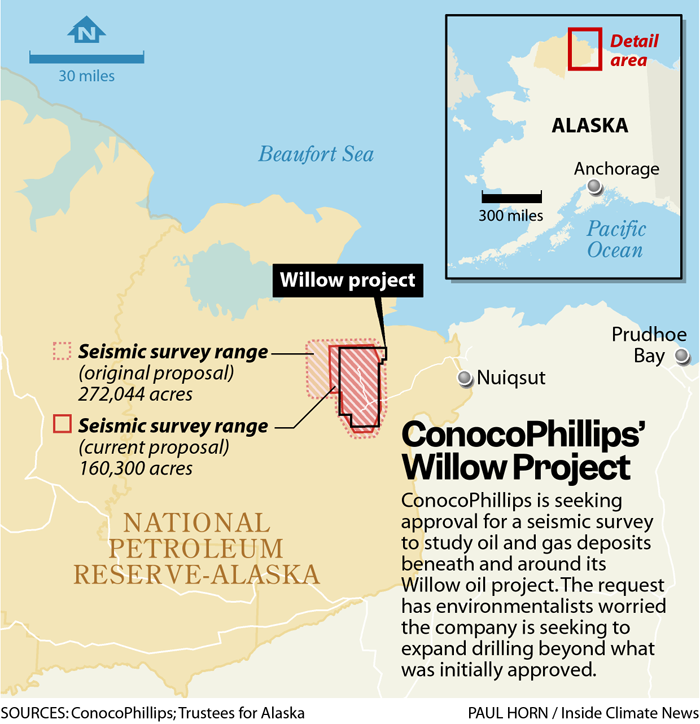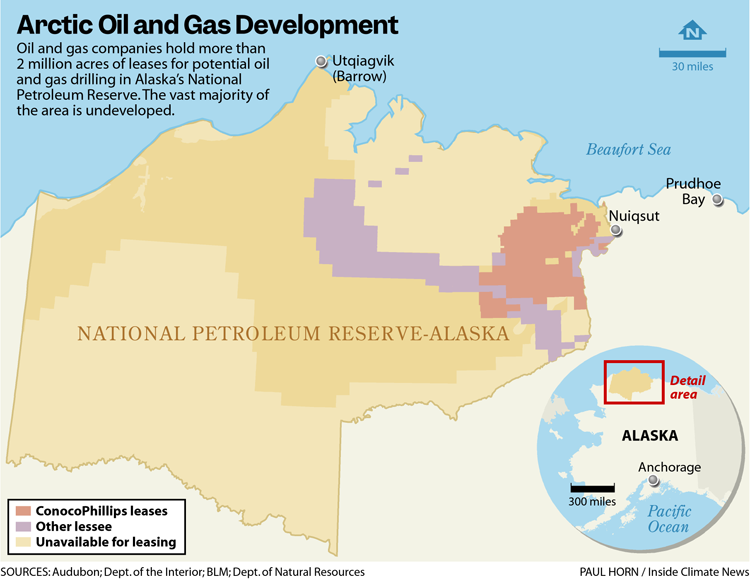Is ConocoPhillips Looking to Expand its Controversial Arctic Oil Project?
Earlier this month, environmental advocates in Alaska noticed that a new document had been quietly posted on the website of the federal agency that manages a huge swath of Arctic lands.
ConocoPhillips, the company behind the controversial Willow oil project that was approved for the area in March, was now seeking approval for a seismic survey that would examine oil and gas reservoirs beneath the surface.
Alarmingly, the area the company wanted to test extended beyond Willow’s boundaries, stretching farther into the undeveloped wilderness to the north and west.
“Now that Willow has won approval,” warned an update sent to journalists by Earthjustice, an environmental law group that has filed a lawsuit to block the drilling project, “ConocoPhillips appears to be taking steps toward expanding its operations.”
In the proposal, ConocoPhillips said the survey would help the company not only drill more efficient wells for Willow, but also “identify potential future development areas” on lands for which it held leases.
Advocates who have been tracking the project, some of whom would only speak on background, struggled to understand what the filing meant. Many had felt betrayed by the Biden administration’s approval of the Willow project, which would pump nearly 600 million barrels of oil and gas over 30 years from a fragile ecosystem that is warming faster than the global average. Now they wondered whether regulators might approve an initial step towards further oil expansion.
And then on Thursday, without any announcement, the document was replaced with a new version. The sentence that said the seismic tests would identify new areas was gone. The footprint of the proposed work had shrunk. The changes only deepened the questions of what exactly ConocoPhillips is planning, and what the Biden administration might allow.

“This seismic application is troublesome, particularly in light of how ConocoPhillips continually gets what it wants,” said Bridget Psarianos, senior staff attorney with Trustees for Alaska, which is representing environmental groups in a second lawsuit challenging the Willow approval.
In an email, Psarianos referred to earlier examples when ConocoPhillips was able to expand existing, nearby projects after initial approvals and noted that the Willow approval required the company to limit its size from what it had originally sought. Now, she said, “it came back with a seismic application that seeks to explore those very same lands” that had been removed from Willow’s scope. “This needs to stop,” Psarianos added.
The approval of the Willow project was one of the Biden administration’s most controversial decisions on climate and energy. Environmental groups were uniformly opposed to the proposal, saying it was incompatible with Biden’s climate goals. A petition calling for Willow’s rejection garnered millions of signatures.
ConocoPhillips and others in the oil industry, meanwhile, noted that Biden had been calling on companies to pump more oil to help counter the fallout from sanctions against Russia, and that a denial would contradict that request.
Native Alaskans, who make up most of the nearby residents, were split. Some argued that Willow threatened subsistence hunting, public health and their traditional way of life. Others said it would provide jobs and much needed economic support.
Rosemary Ahtuangaruak, the former mayor of Nuiqsut, the Alaska Native village closest to the Willow site, said she is concerned that ConocoPhillips is seeking to add additional drill sites to the project. The company had sought to drill from five well “pads,” but gained approval for only three.
A spokesperson for the Bureau of Land Management, or BLM, did not answer questions about the application, including whether it had asked ConocoPhillips to submit a more limited version, and said only that it was reviewing the proposal and would conduct an environmental assessment.
ConocoPhillips did not answer questions about why it had replaced its initial proposal or whether the seismic survey could still be used to identify new areas for development.
In a statement, Dennis Nuss, a company spokesperson, said: “The purpose of the program is to acquire high quality seismic data to optimize subsurface development, including downhole well placement at the three pads approved in the March 2023 Willow record of decision. Seismic is a routine and essential part of typical oil and gas operations.”
The application for a seismic survey comes as a judge is expected to rule soon on the two lawsuits brought by environmental groups seeking to overturn the approval of Willow. The groups have argued that the Biden administration failed to adequately assess environmental impacts of the project, including how it would worsen climate change. The parties have asked for a ruling by early November.
ConocoPhillips’ seismic proposal said the company is seeking to run a survey, which involves thumping the ground with giant machines, across 160,300 acres surrounding the Willow project. The initial application asked for testing across 272,044 acres. Willow would be the western-most oil project along Alaska’s North Slope, extending deeper in the National Petroleum Reserve. The 23 million acre reserve is managed by the BLM, and while it was originally set aside as an oil supply for the Navy, it is mostly undeveloped wilderness.

ConocoPhillips holds 1.1 million acres of leases across the reserve, according to Audubon Alaska, and in 2021 a company executive said Willow could be the “next great Alaska hub” and would help the company access up to 3 billion barrels of oil and gas nearby. Willow, then, could serve as a stepping stone to further development. The seismic application, activists feared, was confirmation that ConocoPhillips was continuing with this goal.
Even the seismic survey itself would be damaging, Ahtuangaruak said. People in Nuiqsut rely on caribou as a critical food source, and an important herd migrates through the area where seismic testing would take place. Ahtuangaruak said the migration begins between February and April, and ConocoPhillips’ proposal said the survey would run from January through April.
The testing would require a mobile camp that would include dozens of pieces of heavy equipment and vehicles and trailers to house workers, all of which could scare off the animals.
“When you put in the seismic activity in this area where we’re depending on the animals to migrate through, you’re committing that they’re not going to get there,” Ahtuangaruak said. “We’ve stated this over and over and over.”
The proposal does not mention any measures to avoid caribou.
As of Friday, the bureau’s website said it would open the proposal to public comments once an environmental assessment is completed. In its application, ConocoPhillips said it wanted to begin work as soon as mid-November.
By that point, environmental groups hope to have a ruling on the lawsuits, which could potentially block all development associated with Willow.
Share this article
Disclaimer: The copyright of this article belongs to the original author. Reposting this article is solely for the purpose of information dissemination and does not constitute any investment advice. If there is any infringement, please contact us immediately. We will make corrections or deletions as necessary. Thank you.







